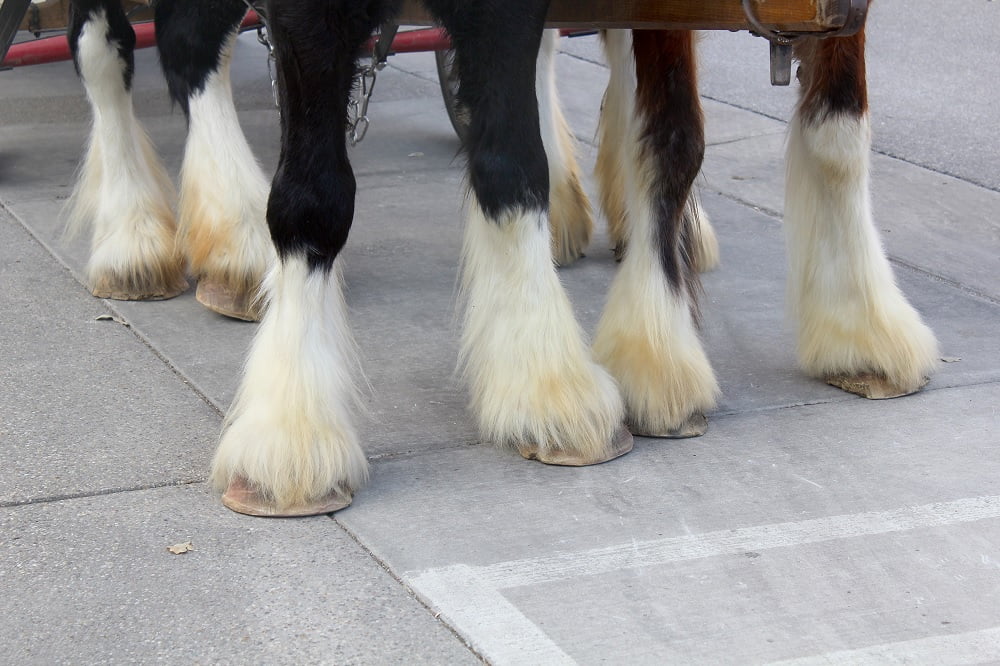Have you ever seen a Clydesdale horse up close?
If you have, you’ll know that these magnificent creatures are more than just horses; they’re a symbol of strength, grace, and a touch of Scottish charm. Clydesdales have a long and storied history, and in this article, we’re going to dive into the world of these gentle giants.
Clydesdales are a breed of draft horses known for their incredible size, gentle nature, and rich history. So, whether you’re a seasoned equestrian or just someone with a soft spot for horses, let’s explore everything you need to know about these remarkable animals.

The History of Clydesdales
The Clydesdale breed originated in Scotland, in the region of Lanarkshire, along the River Clyde, which is how they got their name. These horses were initially bred for heavy farm and industrial work, thanks to their substantial build and incredible strength. Over time, Clydesdales gained popularity as a working horse throughout Scotland and, eventually, the world.
In the 19th century, Clydesdales were exported to North America, where they played a crucial role in the development of the continent. They were used for plowing fields, hauling timber, and even delivering goods. Their massive build and willingness to work endeared them to the people of North America.
Characteristics of Clydesdales
Clydesdales are known for their distinctive appearance. Here are some key characteristics that set them apart:
Size and Build
Clydesdales are one of the largest horse breeds in the world. They can stand as tall as 18 hands high (6 feet at the shoulders) and weigh up to 2,400 pounds. Their massive build is designed for heavy work, making them ideal for tasks like plowing fields or pulling wagons.
Coat Color
Clydesdales are easily recognized by their bay color, which is a reddish-brown body with white markings on the face, legs, and belly. The white markings often resemble white “socks” on their legs and a white blaze on their face.
Feathers
One of the most distinctive features of Clydesdales is the “feathering” on their lower legs. These are the long, silky hairs that extend down from their knees and hocks. The feathers give Clydesdales a regal and elegant appearance.
Docile Temperament
Despite their imposing size, Clydesdales are known for their gentle and docile nature. They are friendly and approachable, making them a favorite among horse enthusiasts and non-enthusiasts alike. Clydesdales are often used for horse-drawn carriages and in therapy programs due to their calm demeanor.
Strength
Clydesdales are renowned for their raw power. They can pull heavy loads with ease, and their strength has made them invaluable for various types of heavy work. Even today, they’re used in parades and exhibitions to showcase their incredible strength.

Frequently Asked Questions (FAQs)
1. How did Clydesdales get their name?
Clydesdales are named after the River Clyde in Scotland, near their place of origin.
2. What is the purpose of Clydesdales today?
While they are no longer used for heavy labor, Clydesdales are often seen in parades, shows, and exhibitions. They’re also used in promotional events, especially by a well-known beverage company.
3. How long do Clydesdales live?
Clydesdales typically live to be around 20–25 years old, although some may live longer with proper care.
4. Are Clydesdales good for riding?
While they can be ridden, Clydesdales are more commonly used for driving (pulling carts or carriages) due to their size and strength.
5. Do Clydesdales make good pets?
Clydesdales are known for their friendly nature and can be wonderful companions. However, owning a horse of this size requires ample space and resources.
6. What is the average height of a Clydesdale?
The average height of a Clydesdale is around 16–18 hands (64–72 inches) at the shoulders.
7. How much does a Clydesdale horse weigh?
Clydesdales can weigh up to 2,400 pounds, although some individuals may be lighter.
8. Are Clydesdales endangered?
Clydesdales are not considered endangered, but their numbers are relatively small compared to some other horse breeds.
9. What is the lifespan of a Clydesdale?
The average lifespan of a Clydesdale is 20–25 years, although many factors can influence their longevity.
10 Do Clydesdales have any unique health concerns?
Clydesdales, like all horse breeds, can be susceptible to various health issues. It’s essential to provide them with proper care, including regular veterinary checkups.
Conclusion
In the world of horses, Clydesdales are true icons. Their remarkable size, gentle nature, and historical significance make them a breed like no other. Whether they’re pulling a carriage in a parade or starring in a commercial, Clydesdales continue to capture our hearts with their majestic presence.
If you’re ever lucky enough to meet a Clydesdale up close, take a moment to appreciate these gentle giants and their enduring legacy in the equine world. Clydesdales are more than just horses; they’re a testament to the enduring bond between humans and animals.
References
Edwards, E. H. (2002). The Encyclopedia of the Horse, DK Adult
Lynghaug, F. (2009). The Official Horse Breeds Standards Guide: The Complete Guide to the Standards of All North American Equine Breed Associations Voyageur Press.
Philip, C. (2006). Clydesdale Horses, Capstone
International Museum of the Horse (n.d.) The Clydesdale Horse https://imh.org/exhibits/online/the-clydesdale-horse/.
External Links
- Clydesdale Breeders of the USA: Official website of the Clydesdale Breeders of the USA
- The Clydesdale Horse Society: is the official society for Clydesdale horses in the United Kingdom.
- American Livestock Breeds Conservancy: Learn more about livestock conservation efforts and Clydesdales’ place in history.
- Clydesdale Heritage: A site dedicated to preserving the heritage of the Clydesdale breed
Feel free to explore these references and external links for more in-depth information about Clydesdales.
For more information on Clydesdales and other beloved pet breeds, visit Top Pet Breeds and dive into the world of pets.
Call to Action: Have a Clydesdale horse as a companion? Share your Clydesdale stories with us at admin@toppetbreeds.com. We’d love to hear from you!
And remember, the Clydesdale isn’t just a horse; it’s a symbol of history, power, and grace.

